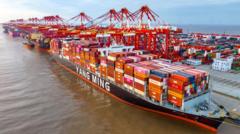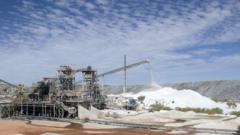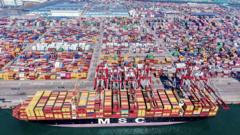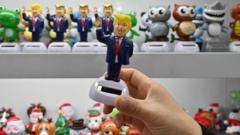In 2025, the global economy is expected to maintain a lackluster growth rate of 3.2%, as per the International Monetary Fund (IMF), shadowed by potential shifts in U.S. trade policies under Donald Trump, whose return to politics is raising concerns about isolationist tendencies. In December, borrowers received a boost from a third consecutive interest rate cut, yet sharp declines in stock markets ensued due to caution expressed by Federal Reserve Chair Jerome Powell regarding future cuts amid ongoing inflation challenges. Inflation rates climbed to 2.7%, 2.2%, and 2.6% in the U.S., eurozone, and UK respectively.
**Global Economy Faces 'Trump 2.0' Uncertainty Amid Inflation and Trade Tensions**

**Global Economy Faces 'Trump 2.0' Uncertainty Amid Inflation and Trade Tensions**
As Donald Trump reenters U.S. politics, new tariffs may disrupt global trade and increase prices, posing challenges for economies worldwide.
While price rises have slowed significantly since the pandemic and the Ukraine war, economic uncertainty looms, predominantly driven by Trump's tariff threats against major trading partners like China, Canada, and Mexico. Experts warn that these tariffs could spur immediate U.S. growth but severely impact nations reliant on trade with the U.S., particularly Mexico and Canada. Maurice Obstfeld, a former chief economist at the IMF, points out that increased tariffs could disrupt the automotive industry, triggering widespread economic repercussions.
Amid these challenges, China's economy faces its own struggles, grappling with domestic issues and potential reduced demand for exports due to U.S. tariffs. While the World Bank recently raised China's growth forecast for 2025 from 4.1% to 4.5%, the nation remains attentive to foreign investment amidst U.S.-China tensions. The electric vehicle sector is expected to continue as a focal point in trade disputes, pressing the U.S., Canada, and the EU to impose tariffs, which China argues are unjust.
European economic leaders express concern over the ramifications of U.S. tariffs, especially as the eurozone confronts stagnation fueled by political instability and high inflation rates. In the UK, rising taxes and wages also threaten to elevate costs for consumers. Meanwhile, labor market stagnation is noted as a probable result of sluggish overall growth.
As Trump prepares for a potential economic agenda focusing on tax cuts and deregulation, experts speculate that U.S. policies could drive further global disparities. However, they remain hopeful that worldwide inflation could subside, contingent upon the direction of U.S. fiscal strategies.
The unfolding dynamics in 2025 will be pivotal in determining the trajectory of global economic integration and inflationary pressures as key stakeholders adapt to the ever-changing landscape.
Amid these challenges, China's economy faces its own struggles, grappling with domestic issues and potential reduced demand for exports due to U.S. tariffs. While the World Bank recently raised China's growth forecast for 2025 from 4.1% to 4.5%, the nation remains attentive to foreign investment amidst U.S.-China tensions. The electric vehicle sector is expected to continue as a focal point in trade disputes, pressing the U.S., Canada, and the EU to impose tariffs, which China argues are unjust.
European economic leaders express concern over the ramifications of U.S. tariffs, especially as the eurozone confronts stagnation fueled by political instability and high inflation rates. In the UK, rising taxes and wages also threaten to elevate costs for consumers. Meanwhile, labor market stagnation is noted as a probable result of sluggish overall growth.
As Trump prepares for a potential economic agenda focusing on tax cuts and deregulation, experts speculate that U.S. policies could drive further global disparities. However, they remain hopeful that worldwide inflation could subside, contingent upon the direction of U.S. fiscal strategies.
The unfolding dynamics in 2025 will be pivotal in determining the trajectory of global economic integration and inflationary pressures as key stakeholders adapt to the ever-changing landscape.




















